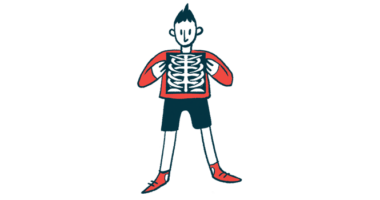Two genes, NAIP and SMN2, may help determine SMA’s likely severity
Study finds NAIP deletion in most children with type 1, but not type 2, disease

Genetic alterations related to two genes, SMN2 and NAIP, could help to predict the severity of spinal muscular atrophy (SMA), according to a recent analysis.
Among patients with SMA type 1 and type 2 in Egypt, all of whom had standard disease-causing mutations in the SMN1 gene, fewer copies of SMN2 and a loss of NAIP were associated with more severe type 1 disease.
“Analysis of NAIP deletion alongside assessing SMN2 copy number might enhance the effectiveness of the diagnosis that can predict severity among Spinal Muscular Atrophy patients,” the researchers wrote.
The study, “NAIP Gene Deletion and SMN2 Copy Number as Molecular Tools in Predicting the Severity of Spinal Muscular Atrophy,” was published in Biochemical Genetics.
NAIP gene seen as a possible disease modifier, affecting SMA severity
SMA is caused by mutations in the SMN1 gene, leading to a lack of the SMN protein that’s important for the health of nerve cells involved in motor control. In around 95% of cases, the mutation involves the loss of a protein-coding portion (exon) of the gene, called exon 7, on both inherited copies of SMN1. Often, exon 8 also is deleted.
Disease severity varies by SMA type, with type 1 being the most severe and with earliest onset, while type 4 is milder and typically emerges in adulthood.
SMN2 is considered a backup gene, as it also provides instructions for making SMN protein, although significantly less of the functional protein than SMN1. Two SMN2 gene copies are typical in most people, but some have more. In SMA patients, more SMN2 copies equates to greater SMN production and less severe disease with a later onset.
Other genetic factors may influence SMA severity, but they alone are not enough to cause the disease and, as such, are called disease modifiers.
NAIP, situated near the SMN1 gene in the genetic code, has been proposed as a disease modifier, with a loss in its function associated with more severe disease.
Researchers in Alexandria further investigated how useful a genetic analyses of NAIP and the SMN genes would be in predicting disease severity. Their study involved 65 children with SMA — 30 with type 1 and 35 with type 2 — as well as 65 healthy children, all tested for variations in SMN1, SMN2, and NAIP.
All 65 patients, but not the healthy children, were found to have an exon 7 deletion in SMN1. This was accompanied by exon 8 deletion for 90% of those with SMA type 1, and 88.6% of those with type 2 disease.
Notably, more than half of the type 1 patients (56.7%) — 17 out of 30 children — also had a deletion in NAIP, whereas this deletion was seen in less than a quarter (22.9%) of children with type 2 disease (eight of 35 children).
Essentially, the finding supports previous work suggesting that for patients affected by an exon 7 and 8 deletion in both SMN1 copies, additional genetic alterations in NAIP contribute to more severe disease.
Most severe SMA cases had disease-causing SMN1 deletions and NAIP deletion
The mean number of SMN2 copies was significantly lower in patients with SMA type 1 (1.6 copies) than SMA type 2 (three copies). Correspondingly, SMN2 gene activity was significantly higher in those with type 2 relative to type 1 disease.
Ultimately, the scientists sorted individuals into five groups (A-E) based on their SMN1 and NAIP genetic profile, with subgroups (1-4) based on the number of SMN2 copies.
Group A1, where SMN1 exons 7 and 8 and exon 5 in NAIP are deleted, and only one copy of SMN2 is present, was generally the most severe group, only observed in people with SMA type 1.
Most with SMA type 2 were in group B, where exons 7 and 8 of SMN 1 were deleted, but NAIP was retained in full.
All healthy children were in E groups, where SMN1 exons 7 and 8 are present and NAIP has no deletions. None of this study’s patient fell into these groups, but the researchers noted that any SMA patient with an E group classification would be expected to have other, more subtle mutations in one or both SMN1 gene copies.
Indeed, additional analyses identified more subtle genetic variants in the evaluated genes that also associated with specific SMA type, and therefore might contribute to disease severity.
Researchers emphasized that evaluating and understanding these smaller genetic changes could be particularly important for predicting disease severity in patients without a standard large deletion in both SMN1 copies.
“This approach can provide valuable insights into the relationship between genotype [genetic makeup] and phenotype [disease severity] in SMA, and help develop more effective diagnostic and therapeutic strategies,” they concluded.








